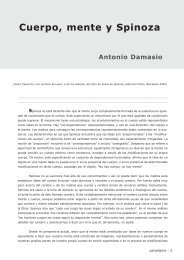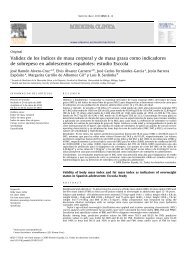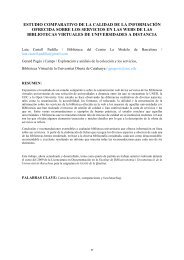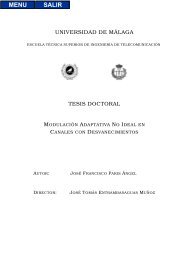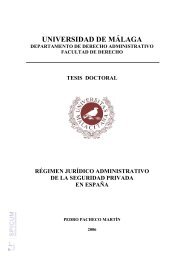Papel de las actividades superóxido dismutasa y catalasa en la ...
Papel de las actividades superóxido dismutasa y catalasa en la ...
Papel de las actividades superóxido dismutasa y catalasa en la ...
You also want an ePaper? Increase the reach of your titles
YUMPU automatically turns print PDFs into web optimized ePapers that Google loves.
1. Introduction<br />
S<strong>en</strong>egalese sole culture (Solea s<strong>en</strong>egal<strong>en</strong>sis, Kaup 1858) is nowadays a very<br />
promising industry in the Mediterranean countries [1]. One of the most serious<br />
problems concerning sole production is the exist<strong>en</strong>ce of infectious diseases,<br />
pseudotuberculosis caused by Photobacterium damse<strong>la</strong>e subsp. piscicida, being the<br />
main limiting factor [2].<br />
In fish farms, control of this bacterial pathog<strong>en</strong> is achieved by the<br />
administration of chemotherapeutic ag<strong>en</strong>ts. However, over the <strong><strong>la</strong>s</strong>t <strong>de</strong>ca<strong>de</strong>, drugresistant<br />
strains carrying a transferable R-p<strong><strong>la</strong>s</strong>mid have evolved, making treatm<strong>en</strong>t with<br />
antimicrobial chemotherapeutics less successful [3]. Therefore, immunoprophy<strong>la</strong>xis has<br />
become the best way to prev<strong>en</strong>t pseudotuberculosis [4].<br />
Throughout the <strong><strong>la</strong>s</strong>t 20 years, there has be<strong>en</strong> a variety of studies analyzing the<br />
effectiv<strong>en</strong>ess of immunization in prev<strong>en</strong>ting pseudotuberculosis [5]. A dival<strong>en</strong>t vaccine<br />
against V. harveyi and P. damse<strong>la</strong>e subsp. piscicida for sole has be<strong>en</strong> reported [6]. This,<br />
however, only provi<strong>de</strong>s protection for a short period. Therefore, searching for new<br />
prophy<strong>la</strong>ctic methods, such as immunostimu<strong>la</strong>nts or probiotics seems a very promising<br />
alternative.<br />
Probiotics have be<strong>en</strong> <strong>de</strong>fined as live microbial preparations that improve the<br />
health and well-being of the host [7-10]. The research on probiotics for aquatic animals<br />
is increasing with the <strong>de</strong>mand for <strong>en</strong>vironm<strong>en</strong>t-fri<strong>en</strong>dly aquaculture. Most of these<br />
studies have be<strong>en</strong> re<strong>la</strong>ted to chall<strong>en</strong>ge trials and suppression of pathog<strong>en</strong> growth by<br />
probiotic bacteria [11-21]. Rec<strong>en</strong>t works have be<strong>en</strong> focused on the immunological<br />
<strong>en</strong>hancem<strong>en</strong>t of fish <strong>de</strong>f<strong>en</strong>ce mechanisms by probiotic bacteria [22-27] and the effects<br />
that dietary administration of probiotics could exert on the intestinal microbiota of the<br />
host fish [28].<br />
As immunomodu<strong>la</strong>tors, probiotics may <strong>en</strong>hance phagocytic activity and increase<br />
the production of reactive oxyg<strong>en</strong> species by macrophages from species such as gilthead<br />
seabream [27, 29] and rainbow trout (Onchorynchus mykiss) [22]. The means of<br />
invasion and survival of P. damse<strong>la</strong>e subsp. piscicida insi<strong>de</strong> the host are still unknown,<br />
and while authors have reported the pres<strong>en</strong>ce of intact bacteria insi<strong>de</strong> fish cells,<br />
3




